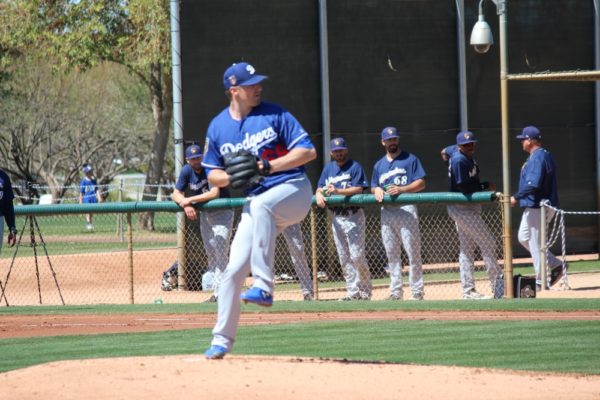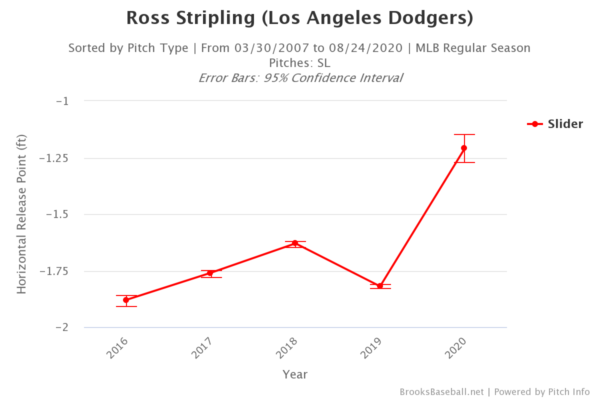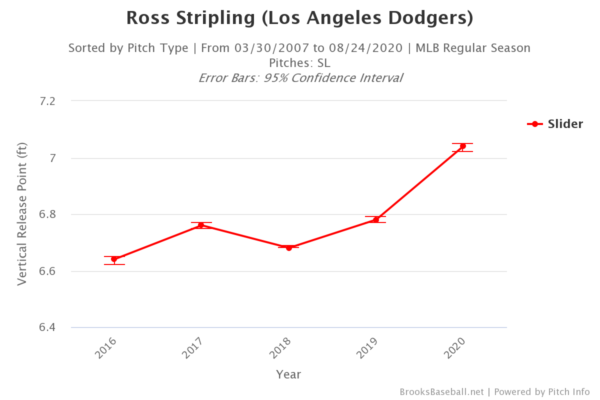
Ross Stripling is struggling. There’s no other way to put it. After a strong 2020 debut that saw him allow one run in seven innings to the Giants, he has been quite bad.
- 6.75 ERA
- 22 2/3 IP (5 games)
- 1.017 OPS against
- 3.6 HR/9
Ugly.
He’s leaning more on his fastball this season, which has ticked up in velocity (from 90.6 to 91.7 MPH). With the velo and spin rate increase (from 2,274 RPM in 2019 to 2,306 RPM in ’20), he has thrown it more — 44.6 percent, which would be a career-high. As a 4-pitch pitcher without plus-velocity, he shouldn’t have to lean on his fastball as much as he has so far this season. And it has gotten pounded.
| BA | xBA | SLG | xSLG | wOBA | LA |
| .347 | .381 | .898 | .854 | .516 | 23 |
Of the 10 home runs he has allowed this season, nine have come off the fastball, hence the atrocious slugging percentage against his heater.
The 23-degree average launch angle on balls in play is up 5 degrees from last season. Overall, his ground ball rate has plummeted. Last season, he had a 50.2 GB%. So far this season, it’s 32 percent — 4th-worst among starters (minimum 25 IP). That’s not all bad, as there are some good pitchers following him on the list (Robbie Ray, Dinelson Lamet, Mike Fiers), but for a guy without premium bat-missing stuff and who has never had a ground ball rate worse than 45.4 percent in his career, that’s an issue.
——
Eno Sarris of The Athletic looked, briefly, at Stripling in an article on Thursday. He focused on Stripling’s slider, which has dipped in usage.
“Where has the slider gone?
Chicken Strip is a four-pitch pitcher who has admitted to fashioning his game plan after Hyun-Jin Ryu, but for the first time his his career he’s not throwing the slider 10 percent of the time. He’s nearly halved the usage on the pitch. It’s also lost three ticks on the radar gun, drops four inches more this year, has more horizontal movement than ever, and is being released three inches higher than ever before. The whiff rate has accordingly dropped to the worst of his career — in fact, the new release point has decimated the whiff rates on his breaking balls and only improved his changeup.”
Here it is in table form:
| Year | SLD% | Velo | Whiff | wOBA | H-Mov | V-Mov |
| 2016 | 21.0 | 86.9 | 19.3 | .312 | 2.67 | 2.51 |
| 2017 | 34.3 | 88.8 | 21.2 | .312 | 2.13 | 3.40 |
| 2018 | 25.2 | 87.0 | 21.7 | .344 | 2.80 | 3.46 |
| 2019 | 15.9 | 86.3 | 20.2 | .338 | 2.71 | 3.22 |
| 2020 | 9.9 | 83.9 | 14.8 | .360 | 3.35 | -1.11 |
He’s been slowly reducing his slider usage ever since 2017, but this is the first time he hasn’t thrown it at least 10 percent of the time. Granted, it’s just six starts in a shortened season, but it’s looking more and more like he doesn’t trust it as much or isn’t as comfortable throwing it. And his slider, as Sarris said in his article, it looks different in terms of shape. That has to do with his release points.


Pretty extreme shift in his release points. This is likely what’s impacting the effectiveness of his slider. Because of this, Stripling is throwing his fastball more, which isn’t exactly working out, as we saw above.
——
Alex Wood is on the mend. Tony Gonsolin hasn’t allowed a run in three starts (14 2/2 IP) this season. If Stripling doesn’t turn things around in a hurry, he could find himself relegated to the bullpen, and it might start with him throwing his slider more and relying on his fastball less. If history is any indicator, he won’t be throwing his slider much more out of the ‘pen than he is right now as a starter.
His start on Sunday was better than his previous two (and on par with his one before that), but he’ll need to be closer to the guy he has been in the past rather than the one who has scuffled so far in 2020 if he wants to stick in the Dodgers’ rotation.
 Dodgers Digest Los Angeles Dodgers Baseball Blog
Dodgers Digest Los Angeles Dodgers Baseball Blog